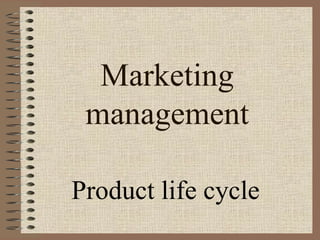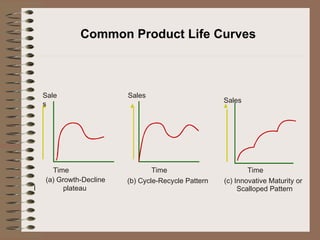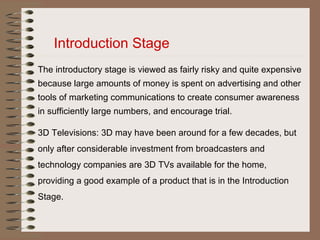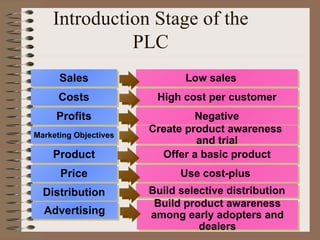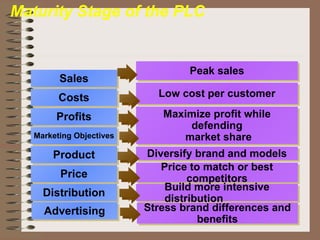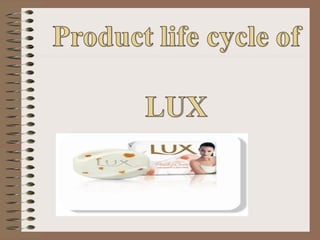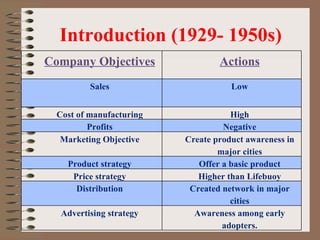Product life cycle
- 1. Marketing management Product life cycle
- 2. Introduction A product is introduced among consumers, and if consumers perceive it as meeting their needs and want, it experiences a period of growth. Subsequently, it reaches the stage of maturity and when it loses its appeal, its decline starts and eventually is may be taken off the market (demise). The classical product life cycle curves are depicted as “S” shaped and generally divided in four stages: Introduction, growth, maturity, and decline.
- 3. Common Product Life Curves Sale Sales Sales s Time Time Time (a) Growth-Decline (b) Cycle-Recycle Pattern (c) Innovative Maturity or l plateau Scalloped Pattern
- 4. Common Product Life Curves Sales Profits Loss Introduction Growth Maturity Decline Time (d) Classical Life Cycle Pattern
- 5. Introduction Stage The introductory stage is viewed as fairly risky and quite expensive because large amounts of money is spent on advertising and other tools of marketing communications to create consumer awareness in sufficiently large numbers, and encourage trial. 3D Televisions: 3D may have been around for a few decades, but only after considerable investment from broadcasters and technology companies are 3D TVs available for the home, providing a good example of a product that is in the Introduction Stage.
- 6. Introduction Stage of the PLC Sales Low sales Costs High cost per customer Profits Negative Create product awareness Marketing Objectives and trial Product Offer a basic product Price Use cost-plus Distribution Build selective distribution Build product awareness Advertising among early adopters and dealers
- 7. Growth Stage The growth stage of life cycle is characterised by a sharp rise in sales. Only a small percentage of new products introduced survive to reach the growth stage. Tablet PCs: There are a growing number of tablet PCs for consumers to choose from, as this product passes through the Growth stage of the cycle and more competitors start to come into a market that really developed after the launch of Apple’s iPad. Another example is NANO car.
- 8. Growth Stage of the PLC Sales Rapidly rising sales Costs Average cost per customer Profits Rising profits Marketing Objectives Maximize market share Product Offer product extensions, service, warranty Price Price to penetrate market Distribution Build intensive distribution Advertising Build awareness and interest in the mass market
- 9. Maturity Stage Most products after surviving competitive battles, winning customer confidence and successful through growth phase enter their maturity stage. The sales plateau, and this flattening of sales usually lasts for some time because most products in the category have reached their maturity stage, and there is stability in terms of demand, technology, and competition. Laptops: Laptop computers have been around for a number of years, but more advanced components, as well as diverse features that appeal to different segments of the market, will help to sustain this product as it passes through the Maturity stage.
- 10. Maturity Stage of the PLC Peak sales Sales Costs Low cost per customer Profits Maximize profit while High profits defending Marketing Objectives market share Product Diversify brand and models Price to match or best Price competitors Build more intensive Distribution distribution Advertising Stress brand differences and benefits
- 11. Decline Stage Decline stage sets in when customer preferences change due to the availability of technologically superior products and consumers’ shift in values, beliefs, and tastes to products offering more value.
- 12. Decline Stage of the PLC Declining sales Sales Low cost per customer Costs Declining profits Profits Reduce expenditure and milk Marketing Objectives the brand Phase out weak items Product Cut price Price Go selective: phase out Distribution unprofitable outlets Reduce to level needed to Advertising retain hard-core loyal customers
- 13. Implications and Limitations of Product Life Cycle Concept Product life cycle concept shows a framework to spot the occurrence of opportunities and threats in a product market and the industry. This can help firms to reassess their objectives, strategies, and different elements of marketing programme.
- 15. Introduction- HUL Hindustan Unilever Limited (HUL) is India's largest FMCG company, touching the lives of two out of three Indians with over 20 distinct categories in home & personal care products and food & beverages.
- 16. INTRODUCTION-LUX 1960 LUX went colored 1929 LUX launched in 1925 India LUX launched in USA as 1916 Toilet soap LUX launched in USA as Laundry soap
- 18. Introduction (1929- 1950s) Company Objectives Actions Sales Low Cost of manufacturing High Profits Negative Marketing Objective Create product awareness in major cities Product strategy Offer a basic product Price strategy Higher than Lifebuoy Distribution Created network in major cities Advertising strategy Awareness among early adopters.
- 19. Growth- (1950s- 1990s) Company Objectives Actions Sales Rising Sales Cost of manufacturing Average cost reduction Profits Positively increasing Marketing Objective Maximise market share Product strategy Offer variants Price strategy To penetrate the market Distribution Intensive network in the entire country Advertising strategy Awareness an interest in mass market
- 20. Maturity-(1990s to till date ) Company Objectives Actions Sales Peak sales Cost of manufacturing Low Profits High Marketing Objective Maximize profit while defending market share Product strategy Diversify brand Price strategy To match the nearest competitor Distribution More intensive focusing on rural area Advertising strategy Multiple brand ambassadors for different variants.
- 21. Thank you
Editor's Notes
- Introduction. In this stage marketers spend heavily on promotions to inform the target market about the new product's benefits. Low or negative profits may encourage the company to price the product high to help offset expenses. companies can concentrate on skimming strategies to generate high profits now or on penetration strategies to build market share and dominant the market for larger profits once the market stabilizes. Product Life Cycle Strategies Product Life-Cycle Strategies This CTR relates to the material on pp. 289 and 293.
- Product Life-Cycle Strategies This CTR relates to the material on pp. 289-290 and 293. Product Life-Cycle Strategies Growth. In this stage the company experiences both increasing sales and competition. Promotion costs are spread over larger volume and strategic decisions focus on growth strategies. Strategies include adding new features, improving quality, increasing distribution, and entering new market segments.
- Product Life Cycle Strategies Maturity. In this stage the company must manage slower growth over a longer period of time. Strategic decisions made in the growth stage may limit choices now. Marketing managers must proactively seek advantage by either market modification to increase consumption, product modification to attract new users (quality, feature, and style improvements), or marketing mix modification in an attempt to improve competitive position. Product Life-Cycle Strategies This CTR relates to the material on pp. 290-292 and 293.
- Product Life-Cycle Strategies This CTR relates to the material on pp. 292-293. Product Life Cycle Strategies Decline. In this stage the costs of managing the product may eventually exceed profits. Rate of decline is a major factor in setting strategy. Management may maintain the brand as competitors drop out, harvest the brand by reducing costs of support for short term profit increases, or drop the product (divest) altogether.

